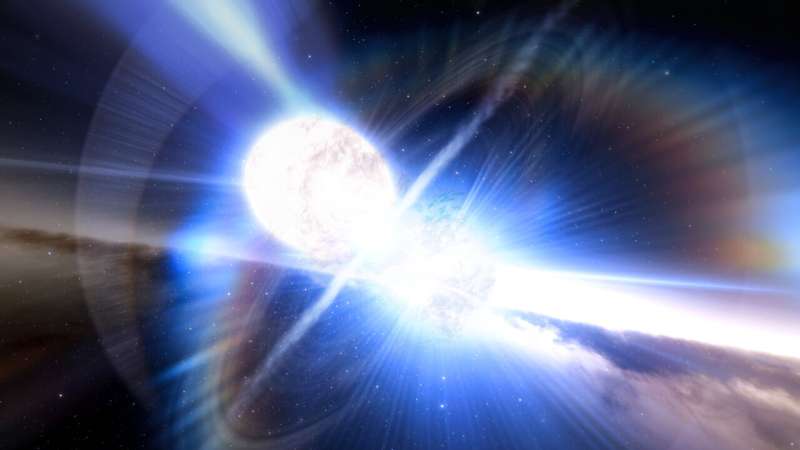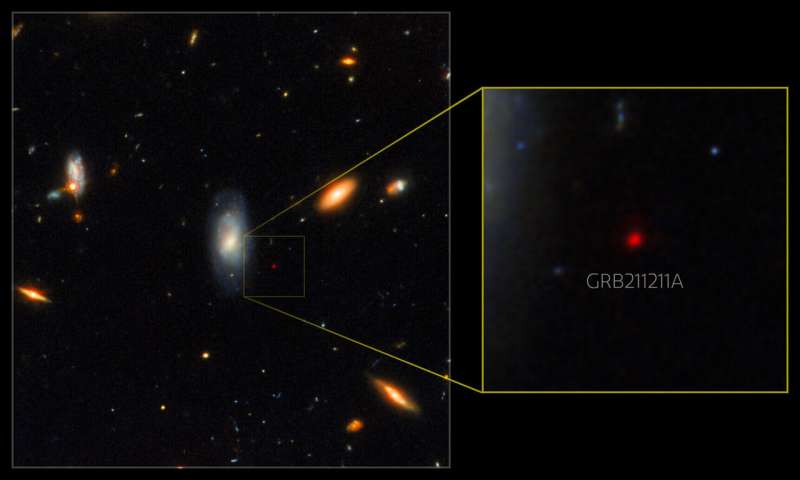For nearly two decades, astrophysicists have believed that long gamma-ray bursts (GRBs) resulted solely from the collapse of massive stars. Now, a new study upends that long-established and long-accepted belief.
Led by Northwestern University, a team of astrophysicists has uncovered new evidence that at least some long GRBs can result from neutron star mergers, which were previously believed to produce only short GRBs.
After detecting a 50-second-long GRB in December 2021, the team began searching for the long GRB’s afterglow, an incredibly luminous and fast-fading burst of light that often precedes a supernova. But, instead, they uncovered evidence of a kilonova, a rare event that only occurs after the merger of a neutron star with another compact object (either another neutron star or a black hole).
In addition to challenging long-established beliefs about how long GRBs are formed, the new discovery also leads to new insights into the mysterious formation of the heaviest elements in the universe.
The research will be published on Dec. 7 in the journal Nature.
“This event looks unlike anything else we have seen before from a long gamma-ray burst,” said Northwestern’s Jillian Rastinejad, who led the study. “Its gamma rays resemble those of bursts produced by the collapse of massive stars. Given that all other confirmed neutron star mergers we have observed have been accompanied by bursts lasting less than two seconds, we had every reason to expect this 50-second GRB was created by the collapse of a massive star. This event represents an exciting paradigm shift for gamma-ray burst astronomy.”
“When we followed this long gamma-ray burst, we expected it would lead to evidence of a massive star collapse,” said Northwestern’s Wen-fai Fong, a senior author on the study. “Instead, what we found was very different. When I entered the field 15 years ago, it was set in stone that long gamma-ray bursts come from massive star collapses. This unexpected finding not only represents a major shift in our understanding, but also excitingly opens up a new window for discovery.”
Fong is an assistant professor of physics and astronomy in Northwestern’s Weinberg College of Arts and Sciences and a key member of the Center for Interdisciplinary Exploration and Research in Astrophysics(CIERA). Rastinejad, a Ph.D. student in CIERA and member of Fong’s research group, is the paper’s first author.
Long division
The brightest and most energetic explosions since the Big Bang, GRBs are divided into two classes. GRBs with durations less than two seconds are considered short GRBs. If a GRB is longer than two seconds, then it’s considered a long GRB. Researchers previously believed that GRBs on either side of the dividing line must have different origins.
In December 2021, the Neil Gehrels Swift Observatory’s Burst Alert Telescope and the Fermi Gamma-ray Space Telescope spotted a bright burst of gamma-ray light, named
GRB211211A. At just over 50 seconds long, GRB211211A initially didn’t appear to be anything special. But located about 1.1 billion light-years away—which, believe it or not, is relatively close to Earth—the astrophysicists decided to study this “nearby” event in detail, using a multitude of telescopes that could observe across the electromagnetic spectrum.
To image the event with near-infrared wavelengths, the team quickly initiated imaging with the Gemini Observatory in Hawaii. After two days of observing with Gemini, Rastinejad worried that she would be unable to obtain a clear view.
“The weather was worsening in Hawaii, and we were so disappointed because we were starting to uncover hints that this burst was unlike anything we had seen before,” she said. “Luckily, Northwestern provides us with remote access to the MMT Observatory in Arizona, and an ideal instrument was being put on that telescope the next day. It was cloudy there, but the telescope operators knew how important this burst was and found a gap between the clouds to take our images. It was stressful but so exciting to get those images in real time.”

This artist’s impression shows a kilonova produced by two colliding neutron stars. While studying the aftermath of a long gamma-ray burst (GRB), two independent teams of astronomers using a host of telescopes in space and on Earth, including the Gemini North telescope on Hawai‘i and the Gemini South telescope in Chile, have uncovered the unexpected hallmarks of a kilonova, the colossal explosion triggered by colliding neutron stars. © NOIRLab/NSF/AURA/J. da Silva/Spaceengine
‘Telltale sign of a kilonova’
After examining the near-infrared images, the team spotted an incredibly faint object that quickly faded. Supernovae don’t fade as quickly and are much brighter, so the team realized it found something unexpected that was previously believed impossible.
“There are a lot of objects in our night sky that fade quickly,” Fong said. “We image a source in different filters to obtain color information, which helps us determine the source’s identity. In this case, red color prevailed, and bluer colors faded more quickly. This color evolution is a telltale signature of a kilonova, and kilonovae can only come from neutron star mergers.”
Because neutron stars are clean, compact objects, researchers previously believed neutron stars did not contain enough material to power a long-duration GRB. Massive stars, on the other hand, can be tens to hundreds of times the mass of our sun. As the dying star collapses, its material falls inward to feed a newly formed black hole. But, thanks to the black hole’s magnetic fields, some of the inward-falling material launches outward at velocities close to the speed of light—powering a GRB.
“When you put two neutron stars together, there’s not really much mass there,” Fong explained. “A little bit of mass accretes and then powers a very short-duration burst. In the case of massive star collapses, which traditionally power longer gamma-ray bursts, there is a longer feeding time.”

This Gemini North image, superimposed on an image taken with the Hubble Space Telescope, shows the telltale near-infrared afterglow of a kilonova produced by a long GRB (GRB 211211A). This discovery challenges the prevailing theory that long GRBs exclusively come from supernovae, the end-of-life explosions of massive stars. © International Gemini Observatory/NOIRLab/NSF/AURA/M. Zamani; NASA/ESA
Changing the search
The event wasn’t the only strange part of the study. The GRB’s host galaxy also is quite curious. Named SDSS J140910.47+275320.8, the host galaxy is young and star-forming, almost exactly opposite of the only other known local universe host of a neutron star merger event: GW170817’s host galaxy NGC4993. To analyze the host galaxy, the team used data from the W.M. Keck Observatory.
“After the detection of GW170817 and its association with a massive, red-and-dead host galaxy, many astronomers assumed that hosts of neutron star mergers in the near universe would look similar to NGC4993,” said Anya Nugent, a Northwestern graduate student and study co-author. “But this galaxy is fairly young, actively star forming and not actually that massive. In fact, it looks more similar to short GRB hosts seen deeper in the universe. I think it changes our view of the types of galaxies we should watch when we’re searching for nearby kilonovae.”
It also changes how astrophysicists might approach the search for heavy elements, such as platinum and gold. Although researchers have been able to study the astronomical factories that produce lighter elements, such as helium, silicon and carbon, astrophysicists posit that supernova explosions and neutron star mergers produce the heaviest elements. Clear signatures of their creation, however, are rarely observed.
“Kilonovae are powered by the radioactive decay of some of the heaviest elements in the universe,” Rastinejad said. “But kilonovae are very hard to observe and fade very quickly. Now, we know we can also use some long gamma-ray bursts to look for more kilonovae.”
Now that the James Webb Space Telescope (JWST) is running, astrophysicists will be able to look for more clues within kilonovae. Because the JWST is capable of capturing images and spectra of astronomical objects, it can detect specific elements emitted from the object. Using the Webb, astrophysicists finally might obtain direct observational evidence of heavy elements’ formation.
“Unfortunately, even the best ground-based telescopes are not sensitive enough to perform spectroscopy,” Rastinejad said. “With the JWST, we could have obtained a spectrum of the kilonova. Those spectral lines provide direct evidence that you have detected the heaviest elements.”
The study paper is titled “A kilonova following a long-duration gamma-ray burst at 350 Mpc.”
More information:
A kilonova following a long-duration gamma-ray burst at 350 Mpc, Nature (2022). DOI: 10.1038/s41586-022-05390-w , www.nature.com/articles/s41586-022-05390-w
Provided by
Northwestern University
Citation:
Surprise kilonova upends established understanding of long gamma-ray bursts (2022, December 7)



